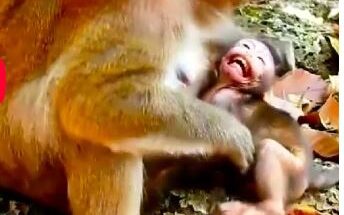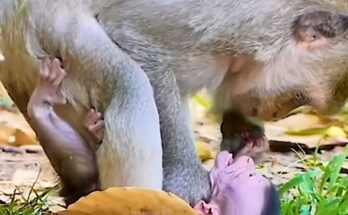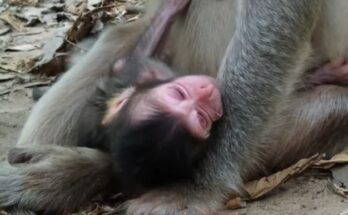In the wild, the bond between a mother monkey and her offspring is a remarkable example of nature’s instinctive nurturing process. Like human caregivers, mother monkeys provide their young with nourishment, protection, and guidance, ensuring their survival and preparing them for independence. This journey from birth to self-sufficiency is marked by close physical contact, gradual weaning, and social integration into the troop.
Early Life and Dependence
From the moment of birth, a baby monkey depends entirely on its mother. She carries the newborn constantly, cradling it against her chest for warmth and security. During these early weeks, the infant clings tightly to her fur, feeling the steady rhythm of her heartbeat and learning to recognize her unique scent and vocalizations. This intimate contact fosters a deep bond and reassures the infant in the unpredictable world of the wild.
The mother’s role extends beyond mere physical support; she provides essential nourishment through her milk. Like in most mammals, breast milk serves as the primary source of nutrition, supplying the infant with the antibodies and nutrients needed for healthy development. For several months, the young monkey relies exclusively on this milk, suckling frequently as it grows stronger each day.
Introduction to Solid Food and Gradual Weaning
Weaning is a crucial stage in a baby monkey’s development. Around three to six months of age, the mother begins introducing her offspring to solid foods by offering bits of fruit, leaves, or insects that she herself eats. At first, the infant mimics her actions, tentatively reaching for food and learning to chew. This period of transition is gradual, with the young monkey continuing to nurse while increasingly consuming solid foods.
The mother actively encourages this change by subtly reducing the frequency of nursing. She may gently push the infant away when it attempts to suckle or move away when it tries to cling to her for feeding. These subtle cues teach the young one to rely more on solid food, signaling that it must begin developing independence.
Teaching Survival and Social Skills
Beyond nourishment, a mother monkey plays a crucial role in teaching her offspring the skills needed for survival. She demonstrates how to find and select food, crack open nuts, or catch insects. Through observation and imitation, the young monkey hones these essential survival techniques.
Socialization within the troop is another vital lesson. The mother gradually allows her offspring to interact with siblings, peers, and other members of the group, fostering relationships that will shape its place in the hierarchy. Playful interactions with other young monkeys help refine motor skills, communication, and social bonds essential for adulthood.
Independence and Continued Guidance
As the weaning process concludes—often between six months to a year—the young monkey becomes more independent. However, the mother’s guidance does not end abruptly. She continues to offer protection and discipline when needed, ensuring that her offspring understands social rules and dangers in the wild.
The transition from infancy to independence is a testament to the dedication and instinctive nurturing of mother monkeys. Through nourishment, guidance, and social teaching, they prepare their young to navigate the challenges of their environment, ensuring the survival and continuity of their species in the wild.


